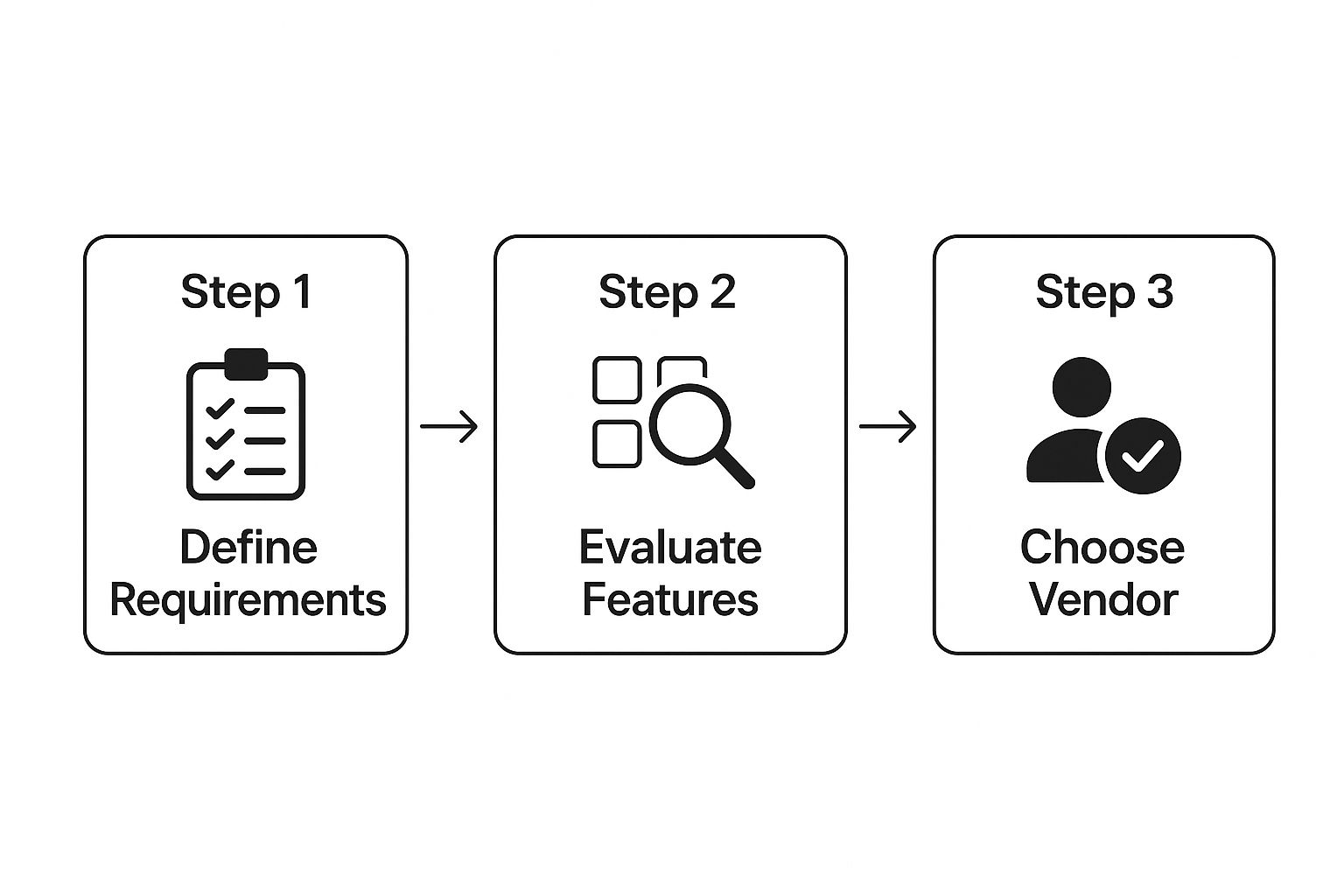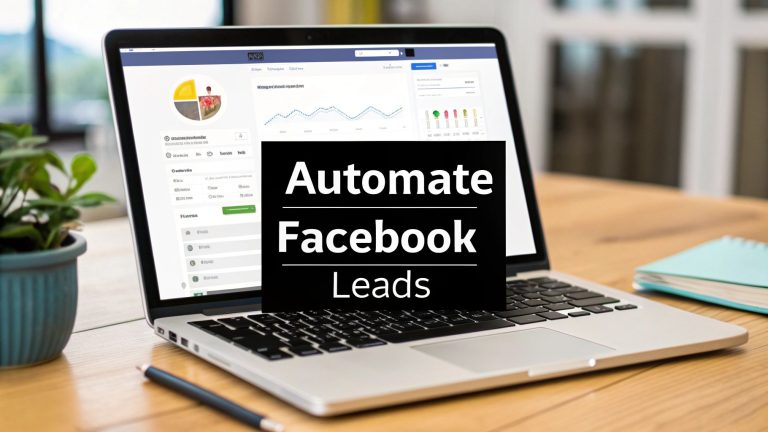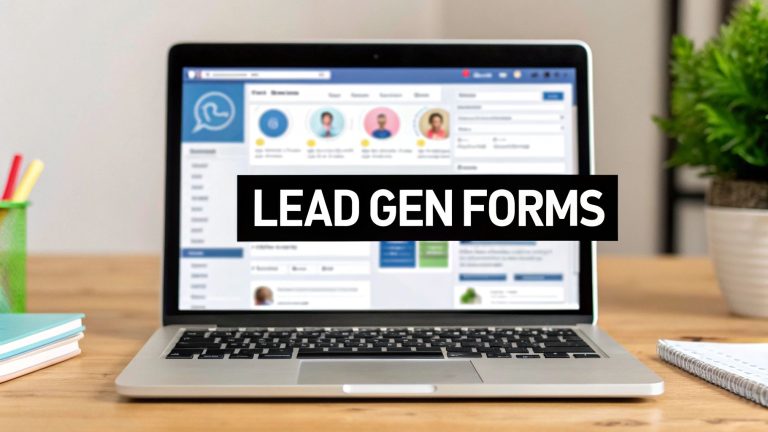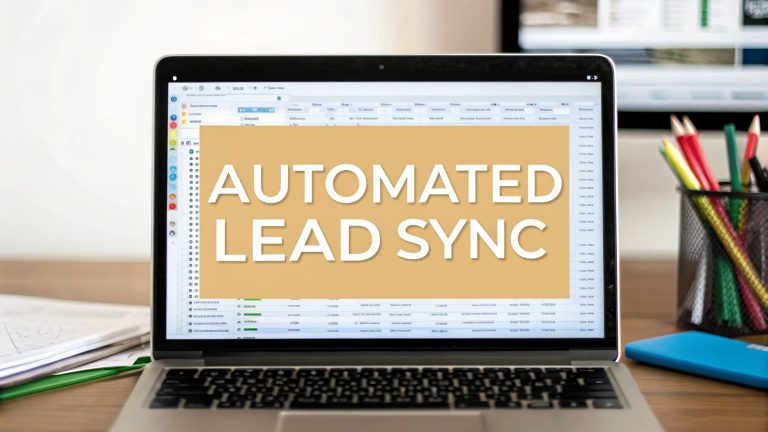Marketing Automation Implementation: A Complete Guide
What Marketing Automation Implementation Really Involves

Let’s be honest about what a successful marketing automation implementation actually takes. It’s so much more than just signing up for a platform like LeadSavvy Pro and flicking on a generic welcome email. That’s barely scratching the surface. A real implementation marks a fundamental change in your marketing operations, shifting from manual, disconnected jobs to an integrated, smart system. Unfortunately, a lot of businesses miss this point, which is why a shocking 73% of implementations are reported to struggle or fail to meet their goals.
Beyond a Simple Email Sequence
The difference between an implementation that thrives and one that fizzles out often boils down to scope. Throwing together a few automated emails is like buying a pre-built shed; it might solve one tiny problem. A proper implementation is like designing and constructing a custom home. It demands a detailed blueprint—a strategy that maps your entire customer journey and pinpoints every key moment where automation can make a difference.
This means you have to think bigger. Consider how you capture leads, what happens after someone downloads your ebook, how you re-engage contacts who’ve gone cold, and how you hand off qualified leads to your sales team without a hitch. The goal is to build an interconnected system where everything works together, not just a few isolated campaigns.
The Honest Truth About Timelines and Commitment
This deeper approach requires a serious investment of time and resources, which can be a reality check for some. A true marketing automation implementation isn't something you can knock out over a weekend. It's a strategic project that can take weeks or even months to plan and execute the right way.
This level of commitment is becoming the new normal. By 2024, almost all marketing leaders reported having at least partially automated their customer journeys, with 70% planning to increase their automation budget in the near future. The reason is simple: for every dollar spent, businesses see an average return of $5.44. An ROI like that is precisely why companies are dedicating real teams and budgets to getting it right. You can explore the full automation statistics here.
This dedication is what separates the winners from those who abandon the project halfway through. Many leaders get excited about what automation promises but are stopped in their tracks by the reality of the upfront work. They expect instant results from a tool, not realizing the tool is only as good as the strategy behind it. Success begins with realistic expectations. Understanding that implementation is a long-term project that involves your people, processes, and technology is the most important first step. With this grounded view, you can avoid the common pitfalls and build an automation foundation that genuinely drives business growth.
Strategic Planning That Sets You Up for Success
Everyone thinks a great marketing automation implementation starts with choosing the right software. It doesn’t. It starts on a whiteboard, a spreadsheet, or even a messy page in a notebook. This is the planning phase, and it’s what separates a tool that gathers digital dust from one that becomes a growth engine for your business. You have to map your route before you start the car.
Auditing Your Current Reality
Before you can build anything new, you need a brutally honest look at where you are right now. Where are the real friction points in your marketing and sales process? Are you still manually downloading CSV files from your Facebook ads every morning? Is your sales team complaining that leads are cold by the time they get them? These pain points are your roadmap.
For a SaaS company, this might be the total lack of a structured onboarding sequence for new trial sign-ups. If you're running an e-commerce store, maybe you have no system in place to remind customers about their abandoned carts. Finding these issues isn't about feeling bad; it's about pinpointing the most valuable opportunities for automation. If you want to dig deeper into this discovery process, check out our guide on marketing process optimization. This first check-in ensures you focus your energy where it will actually make a difference.
Aligning Goals with Business Objectives
Once you've listed your pain points, the temptation is to immediately start building workflows. Hold on for a minute. The next, most important move is tying your automation goals to actual business objectives. It's the difference between saying, "We need a welcome email series," and saying, "We need to increase new customer conversion by 15% in the first 30 days."
This small shift in framing is everything, especially when you need to get buy-in from leadership. They care about results, not features. When you can demonstrate that using LeadSavvy Pro to instantly sync leads will slash response times and directly help the sales team hit their quota, you're speaking a language everyone understands. The key is to start small. Don't try to automate your entire business on day one. Pick one high-impact workflow from your audit and get it right first.
Before diving into the technical setup, it's helpful to assess where your own organization stands. The level of planning required can vary greatly depending on your company's size and the complexity of your automation goals. To help with that, here’s a quick assessment to gauge your readiness.
Implementation Readiness Assessment
Essential preparation steps and resource requirements compared across different business sizes and automation complexity levels.
| Preparation Phase | Small Business | Mid-Size Company | Enterprise |
|---|---|---|---|
| Data & Process Audit | Manual review of spreadsheets and existing customer lists. Informal team discussion on pain points. | A dedicated analyst pulls data from a CRM like HubSpot. Formal review of documented marketing and sales processes. | Formal data governance review across multiple systems. Multi-departmental audit involving BI teams. |
| Goal Setting | Focus on 1-2 core KPIs (e.g., lead conversion rate, first purchase). Goals are often set by the founder or marketing lead. | Department-level quarterly objectives (MQLs, SQLs, pipeline value). Goals are aligned between marketing and sales leadership. | Company-wide strategic objectives tied to revenue and market share. Goals are set by an executive steering committee. |
| Team Alignment | Quick huddles and shared documents. The person implementing is often the person planning. | Cross-departmental workshops and project kickoff meetings. A project manager is assigned to coordinate. | Formal change management process. Communication plans and training sessions for all affected teams globally. |
| Resource Allocation | The founder or a small team handles implementation with existing tools. Budget is limited and reactive. | A dedicated marketing ops person or team. A defined budget for software and potentially some freelance help. | A dedicated implementation team, often including external consultants. A significant, pre-approved budget. |
The key takeaway is that planning scales with your organization. While a small business can be more agile, larger companies require more structure to ensure everyone is moving in the same direction. No matter your size, the principles remain the same: know where you are, where you want to go, and who needs to be involved.
This simple flow chart visualizes the core idea: strategy comes first.

This visual brings home a critical point: defining your specific needs and goals has to happen long before you start looking at software vendors or comparing feature lists.
Spending a few weeks on solid planning now can save you months of headaches and expensive fixes later. This strategic blueprint is the foundation for a smooth and effective marketing automation implementation, making the technical steps that follow much more straightforward.
Technical Setup Without the Headaches
With your strategy mapped out, it's time to dive into the technical side of your marketing automation implementation. This part often seems intimidating, but it’s really about connecting the right pieces in the right order. When you're using a straightforward platform like LeadSavvy Pro, you absolutely don't need to be a developer to get this done.
Data Integrity: Your Automation's Foundation
Before you connect a single tool, take a hard look at your existing data. Trying to automate a messy contact list is a recipe for disaster; it's like trying to build a house on a shaky foundation. Use this as an opportunity to do some spring cleaning on your contact files. Standardize your fields, hunt down and merge duplicates, and make sure your formatting is consistent. A little effort here will save you from major headaches later on.
Integrating Your Core Systems
The goal of this setup is to get your new platform talking seamlessly with your current tools. This usually means installing a tracking pixel on your website to monitor visitor behavior and linking your lead sources, like Facebook Lead Forms, directly into your automation software. You want information to flow automatically, without you having to manually export and import lists.
An intuitive interface is your best friend here. For example, the LeadSavvy Pro dashboard is designed to make these connections clear and simple.

As you can see, it gives you a clear visual of your connected pages and lead sources, taking the guesswork out of the technical side.
This integration step is often where businesses hit a wall. It’s no surprise that while 98% of B2B marketers see automation as vital, a significant 73% find the implementation challenging. This is a persistent issue, especially since 91% of decision-makers are seeing more requests for automation from their teams, which shows how much accessible tools are needed. You can explore more marketing automation statistics here.
Testing, Testing, and More Testing
I can't say this enough: never, ever launch a workflow without testing it from end to end. Think of it as a final dress rehearsal before the show. Just imagine an automated email going out to 1,000 people with a broken FNAME token. A few minutes of testing can prevent that kind of major, customer-facing mistake.
Put yourself in the shoes of a new lead and run through this checklist:
- Does filling out the form actually start the workflow?
- Is the data showing up in your CRM or Google Sheet correctly?
- Are the time delays and conditional branches working the way you expect?
- Do all the personalization fields, like a first name or company, populate with the right info?
Building Workflows That Actually Convert
Let's move past the theory and talk about what really matters: building automation that actually boosts your bottom line. A well-designed workflow is so much more than a series of scheduled emails. It's a responsive conversation that adapts to a customer’s actions, guiding them forward because it feels genuinely helpful, not robotic.
The line between helpful automation and annoying spam is all about relevance. The goal is to create experiences that make customers feel seen and understood, prompting them to act because you’ve anticipated their needs.
Mapping Journeys, Not Just Sequences
A common trap is to think in a straight line: send Email 1, wait three days, send Email 2. But customer relationships are never that simple. You need to map the entire customer journey, complete with all its potential twists and turns. For an e-commerce store, what happens after someone makes their first purchase? Don’t just send a generic "thank you."
Instead, build a workflow that follows up a week later to ask for a review. Then, two weeks after that, send another email with product recommendations based on their specific purchase history. If they click a link to view one of those recommended products, that action should guide them down a completely different path than if they ignored the email. This responsive approach makes your automation feel intelligent, almost like a personal shopper who’s paying attention.
Using Behavior to Fuel Personalization
The real magic happens when you use behavioral triggers. This is the key to making automation feel personal because your system is reacting to what customers actually do, not just their static profile data. A prospect who repeatedly visits your pricing page is sending a powerful signal that they're close to buying.
That specific action should automatically pull them out of a generic newsletter sequence and into a workflow that offers a demo or a free consultation. It's a timely, relevant move that shows you're listening.
Here are a few powerful behavioral triggers you can build workflows around:
- Website Visit: A customer keeps looking at the same product page. Trigger a follow-up email with a special offer or more details about that specific item.
- Video Engagement: Someone watches 75% or more of a product demo video. This is a perfect time to send them a detailed case study about that feature.
- Form Abandonment: A user starts filling out a "Request a Quote" form but gets distracted. A gentle automated reminder an hour later can bring them back to finish.
- Cart Abandonment: For e-commerce, this is a must. An immediate reminder can recover a huge portion of potentially lost sales.
These targeted interactions form the foundation of a strong nurturing strategy. For a deeper look at building these out, explore our guide to automated lead nurturing.
Of course, what works for a SaaS company might not be the best fit for a real estate agent. To give you a practical starting point, we've broken down some of the most effective automation workflows by industry.
High-Converting Automation Workflows by Industry
Core automation workflows and their typical performance metrics across different business sectors
| Industry | Primary Workflow Type | Average Open Rate | Conversion Rate | Implementation Complexity |
|---|---|---|---|---|
| E-commerce | Abandoned Cart Recovery | 45% | 11% | Low |
| SaaS | Trial Onboarding & Engagement | 35% | 15% | Medium |
| Real Estate | New Lead Follow-up | 50% | 5% | Medium |
| Consulting | Content Download Nurture | 40% | 8% | High |
As you can see, "good" performance is relative. An 11% conversion rate on abandoned carts is a massive win for e-commerce, while a 5% conversion from a new lead follow-up can be a game-changer in high-value real estate deals.
When you get it right, your workflows stop feeling like "automation" and start feeling like thoughtful, attentive customer service. They anticipate needs, deliver value at just the right moment, and guide customers toward the best solution. This is how you turn a software tool into a true growth engine for your business.
Getting Your Team Excited About Automation

You can have the best software in the world, but it won't do much if your team isn't ready to embrace it. A successful marketing automation implementation is less about the technical clicks and more about the people using the tool. The biggest challenge isn't setting up a workflow in LeadSavvy Pro; it's showing your team that automation is a powerful partner, not a replacement.
Find Your Automation Champions
Think about your team. There are always a few people who are naturally drawn to new tech. They’re the ones who build clever spreadsheet formulas or find brilliant workarounds for clunky old software. These individuals are your automation champions, and you need to get them involved from the very beginning.
Bring them into the planning stages and show them what's possible. Their excitement will be infectious. When a colleague—not just a manager—demonstrates how a new lead can pop up on their phone in real-time instead of landing in a spreadsheet they check once a day, the value becomes instantly clear. Give these champions the space to teach their peers and celebrate their early wins.
Frame Automation as an Assistant, Not a Replacement
Let's be direct: the number one fear is that automation is coming for people's jobs. It's crucial to address this concern openly. Position automation as a helpful assistant that handles the repetitive, mind-numbing tasks that no one really enjoys doing anyway. This frees up your team’s brainpower for work that actually matters.
Imagine what your team could do if they weren't bogged down by manual data entry or tedious report building. They could:
- Invest more energy in building relationships with high-value prospects.
- Dig deeper into campaign data to uncover what’s truly working.
- Get creative and brainstorm new marketing angles to reach new audiences.
When your team realizes automation is a tool to offload their least favorite tasks, that initial fear often turns into genuine enthusiasm.
Make Training Practical and Ongoing
No one has ever learned a new skill by reading a dense instruction manual. The most effective training is hands-on, relevant, and doesn't end after one session. Run a workshop where everyone builds a simple workflow together, like a welcome email sequence for new sign-ups. This shared, practical experience makes the whole system feel much less intimidating.
Another great idea is to build a library of short, five-minute video tutorials that answer specific questions. When someone forgets how to add a tag or create a segment, they have an easy-to-find resource. The objective isn't to hold a single training event but to create a culture where learning and refining your automated systems becomes a normal, ongoing part of the job.
Measuring Success and Optimizing Your Investment
You've flipped the switch on your marketing automation implementation, and everything is running. It's a great feeling, but now comes the important part: proving it was worth it. It’s tempting to stare at email open rates and click-throughs, but those numbers are just a distraction. They don't show if your automation is actually generating revenue.
To really see the impact, you need to track metrics that directly tie to business growth and show a clear ROI. This is how you show leadership the value of your work and get the green light for future initiatives.
Moving Beyond Vanity Metrics
So, what should you be tracking instead of opens and clicks? Your reporting should focus on numbers that catch the attention of your finance department. For instance, what's the MQL-to-SQL conversion rate for leads who completed your new nurturing sequence? You can directly compare this to the rate for leads who didn't, giving you a clear picture of your workflow's effectiveness.
Another powerful metric is customer lifetime value (CLV). Are customers who experience your automated onboarding sequence sticking around longer or making more purchases? Tracking this can show a direct link between your automation and long-term customer loyalty.
These are the data points that truly validate your efforts. Your LeadSavvy Pro dashboard isn't just for looking at pretty charts; it's a control center. It should tell you which campaigns to pour more resources into and which ones to rethink or pause, helping you be more efficient with your budget and time.
A Practical Approach to Optimization and Scaling
Once you have the right data, you can stop guessing and start making informed decisions. The best way to do this is through consistent improvement, and A/B testing is your most practical tool. Don't try to test everything at once; start with small changes in your highest-impact workflows.
For instance, you could run simple A/B tests on:
- The subject line of your abandoned cart email to see what gets more people to open it.
- The main call-to-action in your trial onboarding sequence. Does "Book a Demo" perform better than "Watch Tutorial"?
- The timing of your follow-up messages. Is it better to reach out after one day or wait for three?
When you discover a winner, don't stop there—scale it. That successful welcome series you perfected for one product line can become a reliable template for others. If a nurturing workflow resonates with one customer segment, think about how you can adapt it for another. Just remember, it's not a simple copy-and-paste job. You'll need to adjust the messaging and offers for the new audience to keep it relevant.
This cycle of measuring, testing, and scaling is how you get the most out of your investment. It’s about building on your successes to create compounding returns. You can explore more ways to expand your efforts in our guide on how to automate lead generation. This constant refinement is what turns a good setup into a core part of your company's growth.
Key Takeaways
Getting marketing automation right is about more than just flipping a switch on a new tool. It’s about building a system that actually works for your business. To get you from planning to seeing real results, here’s a practical guide to keep you on track.
Your Implementation Checklist
Moving from an idea to a live system that helps your business grow requires focus. Keep these core ideas in mind as you start.
- Strategy Before Software: Before you get lost in the exciting features of a new platform, pause and audit your current process. What are you actually trying to achieve? Set a concrete goal, like boosting trial sign-up conversions by 15%. This goal becomes your North Star, guiding every decision you make.
- Data Is Your Foundation: Your automation is only as good as the data powering it. Don’t build your shiny new system on a messy foundation. Take the time to clean up your contact lists—merge duplicates, fix typos, and standardize your fields. It's not glamorous work, but it's critical.
- Build for Behavior: The most effective automation doesn’t just send emails on a schedule; it reacts to what your customers do. Create workflows that trigger when a lead takes a specific action, like watching a product demo or repeatedly visiting your pricing page. This is how you send the right message at the perfect time.
- Empower Your Champions: Find the tech-loving enthusiasts on your team and get them involved from day one. Their genuine excitement and early wins will do more to get everyone else on board than any formal mandate from the top. These are the people who will find cool ways to use the tool and help their colleagues.
- Measure Business Impact: Forget about vanity metrics like email open rates. Focus your reports on what really matters: return on investment (ROI), customer lifetime value (CLV), and how quickly leads are moving through your sales pipeline. These are the numbers that show your efforts are paying off.
Red Flags to Watch For
Even the most carefully laid plans can veer off course. Keep an eye out for these common warning signs.
- The "Boil the Ocean" Approach: It’s easy to get carried away and try to automate every single marketing task at once. If this is your plan, hit the brakes. This approach almost always leads to burnout and a messy system. Start with one, high-impact workflow, prove its value, and then build from there.
- A "Set It and Forget It" Mindset: Marketing automation is not a slow cooker. You can't just set it up and walk away. You need to tend to it. Regularly check your performance data, test new ideas, and fine-tune your workflows to keep things running smoothly.
- Ignoring Team Feedback: If your sales team starts grumbling that the new leads from automation are low-quality, listen to them. Automation should make everyone's job easier, not create new headaches. This feedback is a clear sign that something in your workflow or data needs to be fixed.
Ready to put this into practice with a quick, high-impact win? Get LeadSavvy Pro for free and you can have your Facebook lead capture automated in just a few minutes.







